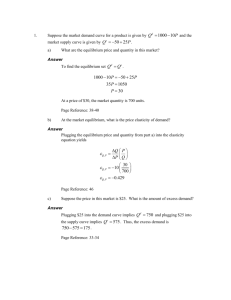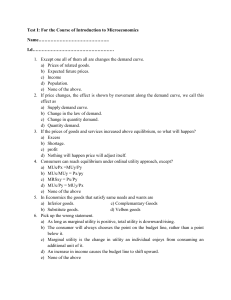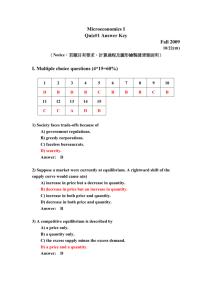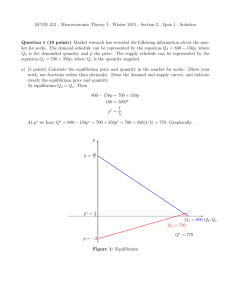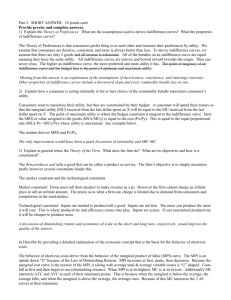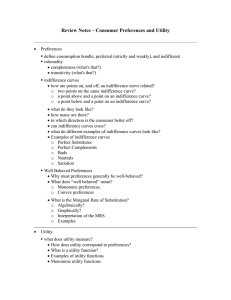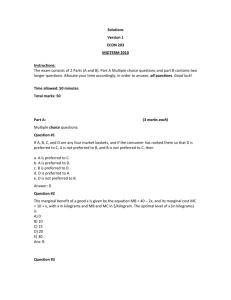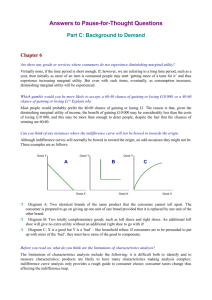Consumer Behavior, Utility Maximization, Indifference Curves
advertisement
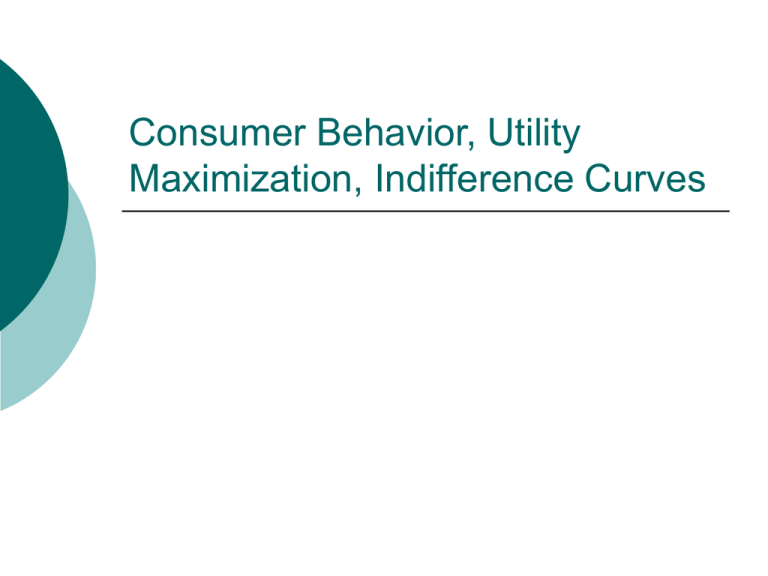
Consumer Behavior, Utility Maximization, Indifference Curves Income Effect Impact Δ price of product has on real income/purchasing power (real vs. nominal) and therefore on quantity demanded Inflation/deflation Objective measure: true regardless of changes in other goods Substitution Effect Impact Δ price product on relative expensiveness and therefore QD Subjective measure: inoperative if everything else gets more expensive too Law of Diminishing Marginal Utility Utility: want-satisfying power 1) not usefulness; 2) subjective; 3) but quantifiable: utils Total utility vs. marginal utility Helps explain demand curve (have to cut prices to sell more as MU diminishes) and elasticity (how quickly MU diminishes: fast= inelastic, slower = elastic) Theory of Consumer Behavior 1) Rational: maximize total utility 2) Preferences: good idea of marginal utility 3) Budget restraint: finite resources + therefore income 4) Prices: product prices not affected by amount individual buys (unlike Bootie Beer stocks) Utility-Maximizing Rule “The consumer should allocate his/her money income so that the last dollar spent on each product yields the same amount of marginal utility” “balance the margins” equilibrium, ceteris paribus Units A: price =$1;B: price =$2; Income $10 A: MU A: MU/$ B: MU B: MU/$ 1 10 10 24 12 2 8 8 20 10 3 7 7 18 9 4 6 6 16 8 5 5 5 12 6 Algebra MU A/$A = MUB/$B Indifference Curves Budget line: a schedule or curve that shows various combinations of two products a consumer can purchase with a specific money income Income Δ Δ curve (up right; down left) Price Δ: if both Δ shift; if one slope Δ Unattainable Attainable (inefficient) Attainable (efficient) Indifference Curve IC: Shows all combinations of two products A and B which will yield the same total satisfaction/utility to a consumer Gets same utility from any combination, so indifferent to which combination Downsloping: more of one means less of the other Convex to origin: diminishing slope as move down marginal rate of substitution: willingness to substitute B for A diminishes as move down curve: as amount of B increase, MU of B decreases while as quantity A decreases MU of A increases (and vice versa) Indifference Map Perfect Substitutes Perfect Complements (l+r shoes) Equilibrium position: intersection budget line and highest indifference curve Difference Marginal Utility Theory and Indifference Curve Theory MUT requires consumer knows MU ICT requires only that knows that different combination generates more or less satisfaction but not how much more/less Nevertheless, at equilibrium Pb/Pa= MUb/MUa so both give same result Deriving a Demand Curve from the Indifference Curve
